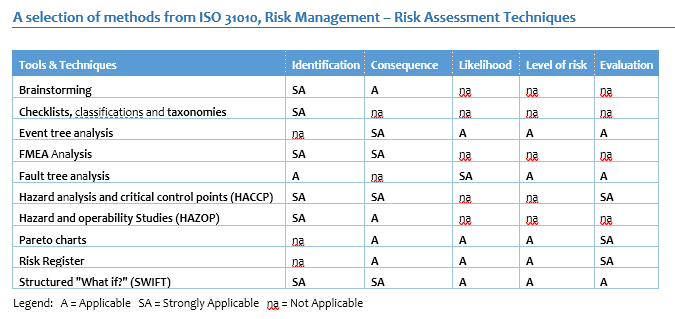| Products | SKU | Attributes | Content | Price | Action |
|---|---|---|---|---|---|
|
Course 725
|
+ ISO 21001 Accredited :: Available on-demand 24/7 |
|
|||
|
Course 726
|
+ ISO 21001 Accredited :: Available on-demand 24/7 |
|
|||
|
Course 727
|
+ ISO 21001 Accredited :: Available on-demand 24/7 |
|
What is ISO 31010?
ISO 31010 is an international standard that provides guidance on risk assessment techniques. It is part of the broader ISO 31000 family of standards on risk management and focuses on helping organizations understand the different tools and strategies that can be used to identify, analyze, and evaluate risks.
What is the difference between ISO 31010 and ISO 31000?
ISO 31000 and ISO 31010 are two related risk management standards developed by the International Organization for Standardization (ISO). They provide guidelines and principles for effective risk management practices within organizations.
However, they have very different purposes, and here are the key differences between ISO 31000 and ISO 31010.
ISO 31000:2018 Risk Management Guidelines
- ISO 31000 is the foundational standard for risk management. It provides a comprehensive framework and guidelines for risk management practices within organizations.
- It offers a high-level overview of risk management principles, processes, and a risk management framework, making it suitable for organizations of all types and sizes.
- ISO 31000 focuses on helping organizations identify, assess, treat, monitor, and communicate risks systematically and structured.
- The standard emphasizes integrating risk management into an organization’s governance and decision-making processes.
- It serves as the umbrella standard for risk management and provides the context and principles organizations can use to develop their policies and procedures.
ISO 31010:2019 Risk Management – Risk Assessment Techniques
- ISO 31010 is a complementary standard to ISO 31000. It guides the selection and application of risk assessment techniques.
- While ISO 31000 sets the framework and principles for risk management, ISO 31010 delves into the practical methods and techniques organizations can use to assess and evaluate risks.
- This standard offers a wide range of risk assessment techniques, such as quantitative, qualitative, and semi-quantitative methods. It provides guidance on choosing the appropriate methods based on the context and objectives of risk assessment.
- This standard helps organizations tailor their risk assessment processes to suit their specific needs and risk management goals.
- ISO 31010 assists in implementing the risk management principles outlined in ISO 31000 by offering a toolbox of risk identification, analysis, and evaluation tools.
In summary, ISO 31000 is the overarching standard that provides a framework for risk management (the theory). At the same time, ISO 31010 is a standard that offers guidance on the practical techniques and methods for conducting risk assessments (the practice).
The Risk Management Tools of ISO 31010
While we don’t like ISO 31000, we love its companion, ISO 31010. This Standard contains 40 plus risk management tools, and while it does not include examples, it sets out how each method can be applied and where it is best used. It contains methods covering all parts of the Risk Management Process, namely,
- Identification (of the threats)
- Consequence (or Severity of the risk event should it occur)
- Likelihood (or probability of occurrence of the risk event)
- Level of Risk (for individual events and combinations of such events
- Evaluation, i.e., consideration of the overall level of risk, risk appetite, and setting the risk acceptance level.
Some examples from ISO 31010 are given in the table.
Click on the image to magnify the view
ISO 31010 Risk Management Courses
deGRANDSON Risk Management Courses include content from both standards. The main focus, however, is on the practical application, with examples, of the multiple techniques to resolve a myriad of common business problems and opportunities.

